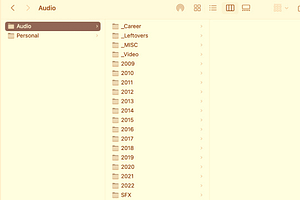
Quick guide to audio file management and naming conventions
I once asked a group of about eight audio makers about file management and the conversation almost ended in a

A couple of times, at various audio workshops I’ve facilitated, an intriguing question has popped up.
‘How do I be funny?’
Humour is a tool I rely on in almost every story I create. It’s become a marker within my style but I find this question dangerous because I would never identify as a comedian. I have no training in comedy. Sadly, a lot of my colleagues would not even consider me ‘funny’ (show yourself, cowards!)
I don’t know how YOU can be funny, because I don’t know how to be funny, other than be born with a sense of humour and come from a funny family.
But I’ve realised, that doesn’t matter. ‘How do I be funny?’ is the wrong question.
What matters is how to capture and create funny audio. You might be personally funny to achieve this, but it’s not a requirement. Being funny and making funny audio is not necessarily the same thing.
If you want to make your stories funnier what matters is looking for funny, encouraging it, and learning (through experience) how to get the most out of those moments.
Framed this way, there are stacks of techniques I use to encourage humour. And I’m going to share them with you right now, with examples.
While I believe there’s always room to explore the spectrum of emotion in any story, the fact is, not every topic will be conducive to humour.
Try looking for stories and topics that lend themselves to humour. While some producers might look down on this as ‘light’ content, in my experience these stories can a/ speak to deeper themes and b/ be harder to pull off because the stakes aren’t as obvious.
Feature-making on the whole is way too serious. There’s a lot of room on the brighter side of the spectrum. Excerpt: The unathorised history of the sausage sizzle, 2019
This sounds basic, but it’s the easiest way to get funny audio. I’m not saying you need to interview Will Anderson, although I’m sure that’d be riotous. By funny, I mean a character. This is a hilarious lady I interviewed at a garage sale. Excerpt: Garage Saleing, 2011
If you’re relaxed and cracking jokes you can create a rhythm, now we have banter, now we have what the Irish call, ‘craic’. If you’re doing these things, and setting this tone, you’re sending strong signals to your guest that they’re safe to be funny. Usually, when there’s one laugh, there’s more.
This is a chat about grass, there should be nothing funny about it, and yet this moment opened the program. Like any good banter, my questions are looking for insight (sure) but also, chances to set my guest up to be funny. Excerpt: Lawn love, 2013
When the guest says something funny, laugh! Nodding and smiling won’t work. When you laugh, the guest will laugh too… If this happens, your chance of getting the AUDIENCE to laugh skyrockets. This is why the laugh-track is so powerful in television, I guess it gives the audience permission to laugh and removes that initial barrier.
Sometimes, it’s appropriate to laugh at your guest. This is one of those dream interview moments. Excerpt: The unathorised history of the sausage sizzle, 2019
Reactions are gold, and you get them by reacting. Think through that for a second.
“Really!?” is the magic question. Bouncing off a ‘really?’ gives energy. It works like active listening in that it allows the guest to expand and reflect on what they just said.
Sit with quirky, specific details, drill into them, challenge your guest on it. The specific is powerful, specific is funny. Only good stuff will happen.
Even when you take it too far, it’s still good tape. Excerpt: Rage ’til you puke, 2017
I have to be honest, a lot of the magic happens in ‘active’ scene tape. Random reactions and funny moments are way more likely when you’re up on your feet, doing something. But you can also plan for them.
I had no idea where this scene would land, but the template (or maybe, structure?) for this moment was mapped out in my head before we did it. Don’t just sit back and hope for a magic moment, prepare for them, plan them, and give yourself every shot at capturing one. Excerpt: Backflip, 2019
When you’re a participant in your story, you are in a perfect position to make fun of yourself. In my experience, this is way easier (and more polite) than making fun of your guest. This is called self-deprecation and it takes many shapes. Excerpt: The shearing game, 2012
Obviously, in your script/read you can be witty and refine your timing (editing for humour is a whole other thing I’m not even going to try and crack open).
One bold move with your writing is to try juxtaposing your script with the tape. When the audience realises you’re lying to them they are suddenly in on the joke. Jonathon Goldstein is a master of this. Excerpt: Punk in a pandemic, 2020
Just like a real comedian, you can use the ‘call back’ technique. This is basically just repeating something. It could something as simple and specific as a brand name. Four people mentioned ‘chicken crimpy shapes’ to me after they heard this story. Again, power in the specific. The last road trip, 2021
Those are just some of the techniques you can try to encourage humour in your storytelling.
This list is certainly not exhaustive, if you think of another technique please tweet me and let me know.
Here are a few funny pieces from some excellent producers that I’d like to recommend:

I once asked a group of about eight audio makers about file management and the conversation almost ended in a

The alleyway is stereotypically dark and long. It’s after 1am, I have no idea where I am and my phone’s about to die.

Here’s what to expect from the ‘Who gives a fork?’ live show touring Aug/Sept 2022.

Jill Beytin, co-founder of Bear Radio, describes where the local scene is at including a juicy story about a recent controversy with one of Germany’s public broadcasters.
get the latest news about upcoming projects:
© 2021 mike williams